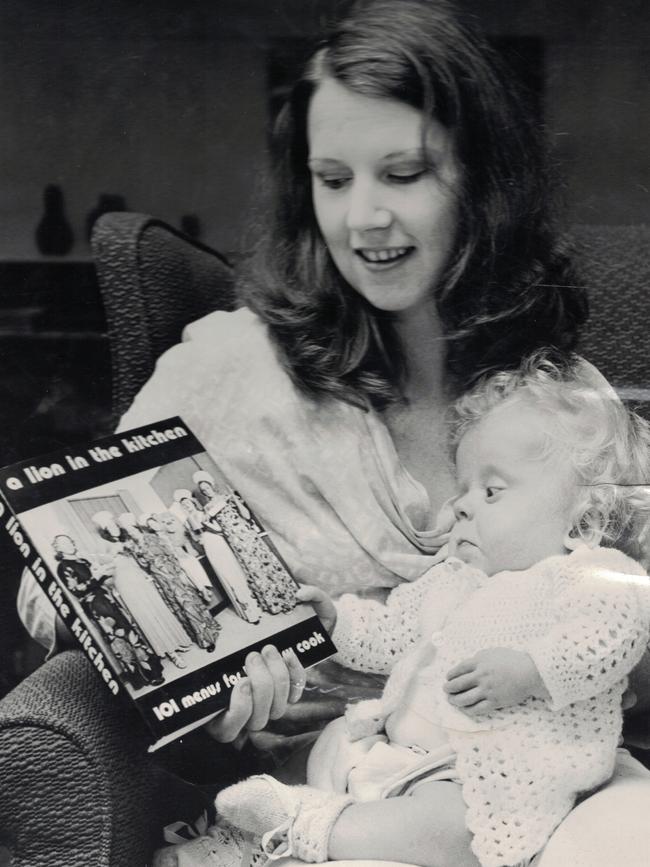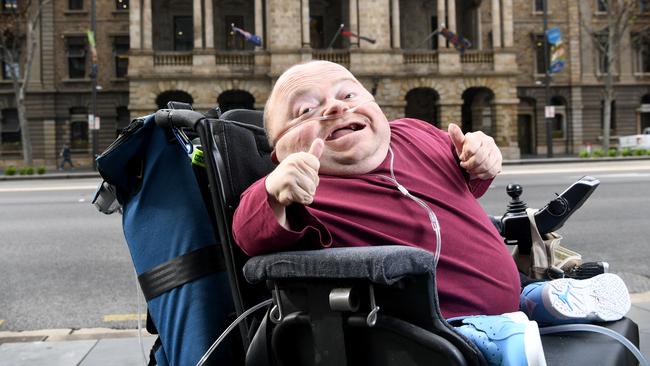Quentin Kenihan: A year on from beloved South Australian passing away
A year after actor, author, broadcaster and Adelaide City Council candidate Quentin Kenihan died, his mother Kerry reflects on her son’s struggles, achievements – and one last poignant phone call.
SA Weekend
Don't miss out on the headlines from SA Weekend. Followed categories will be added to My News.
On October 6, 2018 – a year ago tomorrow – my son Quentin Kenihan phoned while I was away, days from Adelaide.
He told me about his campaign to win a seat on the Adelaide City Council, and he sounded confident.
“Ma (his name for me), come home for the election,” he urged. “I’ll do great things for Adelaide.”
“Quent,” I replied (I called him Quentin, Quent or Q), “this call’s costing a fortune. Hang up.”
He countered, “I have to ring Willesee. He’s really sick.”
Quentin died three hours later, and Mike Willesee four months further on.
I believe Quentin died in his wheelchair during an asthma attack. He managed to call an ambulance and former carer, loyal friend Ian Kissock, who found him in his city apartment as ambulance crews attempted revival.
They’d always responded quickly to Q’s calls.
The voting papers for the election had already been printed. It was too late to delete his name from them. Several people who lived in the CBD told me they’d voted for him after he died to demonstrate support for his aims, and to show their affection for him.
Three weeks later Adelaide City Council and the State Government, working with his siblings, Myles and Sia, organised Quentin’s memorial service.
VIPs including the Governor Hieu Van Le, Mad Max director George Miller, TV’s Ray Martin and Premier Steven Marshall were among hundreds of people who attended. Two Sydney fans had flown to Adelaide to farewell the little bloke whose life on TV and film screens they’d followed.
Many disabled people came, sad to lose their advocate for the handicapped. Actor Russell Crowe and singer Jewel sent video messages.
The bells tolled 43 times, paused and continued, signifying that for as many years, my second son, though severely disabled, had survived a life of pain and uncertainty.
But he’d experienced exciting, fun times too.
Q outlined his life’s highlights to me the very day he died. How many people receive this great privilege?
“Television.” (Too weak to lift a soft toy, he became engrossed in TV.) “My first wheelchair.” “Taking Jana Wendt’s TV job compering for one whole show.” (He was six.) “My second wheelchair,” (an amazing machine designed by American Wally Motloch, enabling Q to sit, stand, be elevated and attend schools for normal children).
“Living with the McLean family at Susan River Homestead, Maryborough, Queensland for six months; and riding a horse.” (To enable Myles, his dedicated carer, to complete HSC without added responsibilities.)
“Singing The Rainbow Connection on The Johnny Young Show.” “Making docos and acting in movies.”
“Crashing the Oscars.” “Helping kids with problems.” “Having my own live show starting on my 40th birthday.”
Regrets?
“Running over Jennifer Lopez’s designer gown when crashing the Oscars in Hollywood. I was almost killed for it.” “Not getting my dog, Patchy, earlier. She kept me sane.” Q also mentioned his love for his siblings (“Myles is my rock,”) Sia and half-brothers Shawn and Chris.
Then, another highlight. “Walking.”
But walking only continued until he was seven.
That was when we brought him back to Australia, after treatment at California’s Stanford University Children’s Hospital. Back home, the treatment was deemed too expensive.
The hospital, subtitled “for children with catastrophic conditions”, was where he met Willesee, and where their on-and-off friendship began in 1983.
But Quentin’s disorder was not catastrophic. He was not terminally ill like most child patients. But his birth, in 1975, and early infancy had been initially catastrophic for me and my family.
He was born with eight fractures. It seemed every time I bathed him I’d break an arm or leg. Feeding him was a nightmare in very early mornings. It could take about four hours holding his milk bottle with my left hand to feed him less than an ounce of milk. This, while, with my right hand, I typed articles for my magazine employer.
But a strong personality emerged when Quentin first spoke complete sentences at 13 months – slow compared to his elder brother by 21 months, Myles, whose first words were Greek at seven months.
My boys bonded quickly.

Following Quentin’s birth, his father Geoff and I formed the Osteogenesis Imperfecta Foundation with doctors, an accountant and Lions’ stalwart Ron Bromley on its board.
Unashamedly taking Quentin on television and radio, I wrote articles to find the more than two children in Australia I’d been told by one specialist had the condition – not a disease.
Here and from New Zealand, 600 families contacted me.
Then, when Quentin was six, I found at Stanford University’s Children’s Hospital a surgeon who said he would help my talkative son to walk.
The small Victorian Vermont Lions Club raised Quentin’s fares to the US. His late father took him first.
In California, steel rods were inserted into his legs but back in Australia they began to migrate through his ankles, requiring another trip to the US.
This time I took Q. On that trip, Quentin’s caring, Catholic surgeon paid for masses to be said to speed his recovery. It was also when Willesee arrived to make a documentary, Quentin.
It won a Logie award.
While my son was being treated at Stanford, I managed the adjoining Ronald McDonald House, then began consoling families of dying and dead kids. I gained community support for mainly mothers to overcome grief and fears. We joined exercise and dance groups, shopped together, talked, and even produced a cookbook.
Quent and I shared our room with a Hawaiian mother and daughter, Ui, who had cancer.
I organised occasional parties for newcomers, especially working fathers.
I kept parents active, to try to stop them succumbing to lonely depression before the house’s only television.
Quentin attended the Stanford hospital school but, daily, conducted what staff called his grand rounds. Armed with a light stick, he’d whack on closed doors, shout, “It’s Quentin. Let me in,” and direct cheery humour to young patients and parents if present.
But the deaths rocked him: 17 friends died in California and after we’d returned home.
In Willesee’s TV documentary, Q was asked, “What’s heaven like?” My son replied, “I dunno. You’ll be there before I am.”
Willesee was unaware that an hour before, Q had learned his best friend, Laura-Jane, aged four, but with astonishing intelligence, had died.
Can you imagine a terminally-ill child could discuss the strategies of Iran’s Ayatollah Khomeini?
The girl had given Q a rose. It died. I decided to discard it. “Never,” he screamed at me.
“That rose is Laura-Jane.”
I kept a basic bar in our room to offer grieving parents alcohol or tea and coffee. I served some drinks to Laura-Jane’s distraught parents and asked them to sit on the floor.
“What was good about Laura-Jane? What was bad?” I queried as we rocked together. They spilled out their anguish. Q could stand in a cot by then. He heard and watched.

Quentin’s physical fragility, with bones which broke as easily as eggshells, was the most severe problem.
When he turned 21, I calculated he’d had at least 1000 fractures. Rolling in bed, sneezing or laughing could result in a break.
Before he left home, I carried a setting kit everywhere, lightweight surgical splints or icy-pole sticks and surgical tape.
My GP friends had instructed me in limb setting. I’d tired of being accused of child battery in hospital emergency departments where we were unknown.
He’d developed an empathy with people enduring extreme sadness, which led him into adulthood and a career in which he played movie roles as disabled or disfigured people, as in Fury Road. He’d anticipated another movie role from George Miller.
Q also assisted and donated to organisations helping the disabled.
He and best mate Filip (Odzak) raised money via a town hall pantomime to aid Queensland flood victims in 2010. At 11, he’d driven his wheelchair from the Adelaide Casino to the Glendi Festival on the main road to convince road planners to make the route more accessible for the disabled.
Police booked him.
By this time, he had his own radio show, following an interview with Bob Hawke.
Q had challenged the PM to a debate on Willesee’s A Current Affair after the government announced funding cuts for certain teachers of the disabled.
After it, Quentin said, “I don’t think Mr Hawke is a very nice man.”
I agreed on learning the PM had called Quentin “a little martinet” who had been set up by his Liberal-minded parents. This was untrue. And Q won.
Legislation was dropped. But Q’s radio career was postponed as he was too politically immature to handle talkback. Years later, Q had his own ABC radio program called BIG. Former PM Julia Gillard was among his first guests.

Q met many famous people including Prince Albert of Monaco, singers Jewel and Jimmy Barnes, Angelina Jolie through Russell Crowe – who once intervened to force an airline to fly him home from Paris where Q’s ticket was denied because he’d requested oxygen on the plane. Of his supportive mate, Quent wrote in his autobiography Quentin: Not All Superheroes Wear Capes, “I am in awe of his talent but even more in awe of his heart.”
Quentin dearly wished to marry and have kids. His childhood sweetheart, Hawaiian Ui, died in 1983 after contracting chickenpox carried to her hospital ward by a casual visitor.
“Don’t tell me about more deaths,” Quent instructed. “I loved Ui. I was returning to California to marry her.”
Older, he enjoyed the company of many caring girls. But the father of one SA girl, who’d agreed to marry Quentin, told him to get lost.
My husband I divorced, like many couples caring for someone disabled.
We’d argued over Q having corrective surgery on his deformed chest (because of teasing). I was for surgery. My husband said I was orchestrating Quentin’s death as the operation had never been attempted on an OI child.
The surgeon agreed it would be psychologically beneficial but, after surgery, Q’s blood wouldn’t oxygenate. He was in ICU for weeks but, obviously, recovered.
Geoff was a good father through the hardest years and his five children loved him.
Q visited him daily in the hospital where Geoff died, just as Q drove his wheelchair before Christmas, 2008, from the city to Flinders Medical Centre.
There, I was in a coma following a cardiac arrest. I owe my life to the rescuing ambos. Years later, they tried but couldn’t save my little man.
Inside his autobiography, Q wrote, “To Mum, 1st edition, 1st off the press. Thank you for teaching me how to write.” He accomplished many ambitions during his extraordinary life.
His brothers and sister grieve quietly.
Quentin changed our lives for the better. Strangers have written to me of their devastation. I can’t reply to those who didn’t annotate their addresses. I thank them and the caring professionals and volunteers who kept him alive and positive for 43 years after I’d been told he’d probably just live for a day or so.
Q beat the odds. I have yet to cry.

